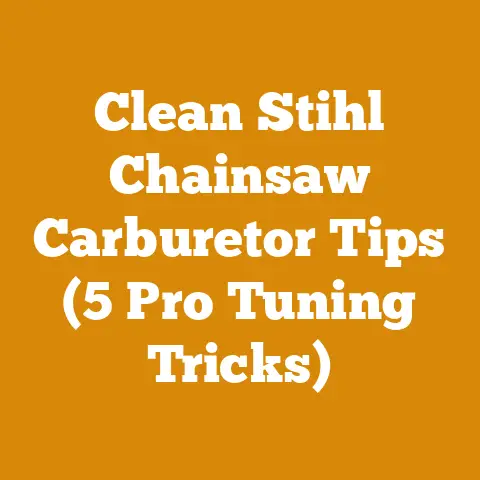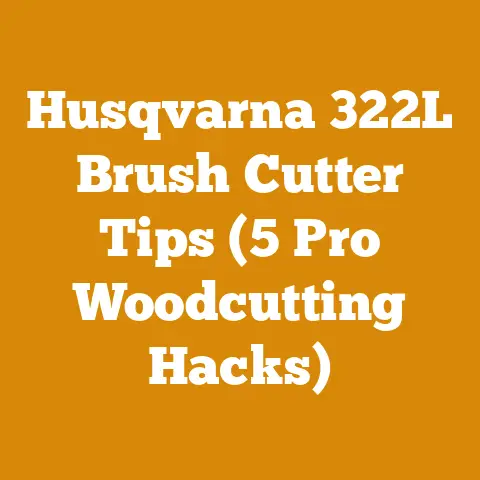Brush Cutter Gas Powered Tips (Expert Arborist Clearing Guide)
Ever felt that knot of frustration tightening in your chest as you stare at an overgrown patch of land? The kind that’s stubbornly resisting your attempts to tame it? I know I have. Many times. It’s a feeling all too familiar to arborists, landscapers, and even homeowners who’ve battled unruly brush. But don’t worry, because I’m here to tell you that with the right knowledge and a gas-powered brush cutter, that frustration can be transformed into a sense of accomplishment. This guide is designed to be your expert companion in mastering the art of brush clearing.
Brush Cutter Gas Powered Tips: An Expert Arborist Clearing Guide
This guide will walk you through everything you need to know to effectively and safely use a gas-powered brush cutter. From choosing the right tool and mastering fundamental techniques to advanced applications and maintenance, I’ll share my experience and insights gained from years of working in the field.
- Select the appropriate brush cutter for their needs.
- Operate the brush cutter safely and efficiently.
- Maintain the brush cutter for optimal performance and longevity.
- Tackle various types of vegetation and terrain.
- Troubleshoot common problems.
- Improve their brush clearing skills and techniques.
This guide aims to fulfill all these needs and more.
What is a Brush Cutter and Why Gas-Powered?
A brush cutter, sometimes called a clearing saw, is a powerful tool designed to cut through thick vegetation, brush, and even small trees. Think of it as a heavy-duty weed whacker on steroids. Unlike string trimmers, brush cutters use metal blades or specialized cutting heads to tackle tougher materials.
Why gas-powered? While electric and battery-powered brush cutters have their place, gas-powered models offer several advantages, especially for larger or more demanding jobs:
- Power: Gas engines provide significantly more power than electric motors, allowing you to cut through thicker vegetation and work for longer periods without bogging down.
- Portability: Gas-powered brush cutters are not tethered to an electrical outlet or limited by battery life. You can take them anywhere you need to go, making them ideal for remote locations or large properties.
- Run Time: With a full tank of gas, you can operate a gas-powered brush cutter for hours, making them more efficient for large-scale clearing projects.
For professional arborists and those tackling substantial brush clearing tasks, gas-powered brush cutters are often the preferred choice.
Choosing the Right Brush Cutter: A Buyer’s Guide
Selecting the right brush cutter is crucial for safety, efficiency, and overall job satisfaction. Here’s what I consider when advising clients:
Engine Size and Power
Engine size is measured in cubic centimeters (cc). A larger engine generally means more power.
- Under 30cc: Suitable for light-duty tasks, such as trimming grass and weeds around obstacles.
- 30-40cc: Good for medium-duty tasks, such as clearing brush and small saplings.
- Over 40cc: Ideal for heavy-duty tasks, such as clearing dense brush, thickets, and small trees.
My Experience: I once used a 30cc brush cutter to clear a small patch of blackberries. It struggled with the thicker canes, and I ended up spending twice as long as I would have with a more powerful model. Learn from my mistake!
Blade Type and Size
The blade is the heart of your brush cutter. Different blade types are designed for specific tasks.
- Brush Blades: These are circular blades with multiple teeth, designed for cutting through brush, weeds, and small saplings. Tooth count and design vary, so choose one appropriate for the density and type of vegetation you’ll be cutting.
- Chisel Tooth Blades: These blades have teeth that resemble those on a chainsaw chain. They are very effective for cutting through thicker brush and small trees.
- Grass Blades: These are lighter blades with fewer teeth, designed for cutting grass and light weeds.
Blade size also matters. A larger blade can cut a wider swath, but it also requires more power.
- 8-10 inch blades: Suitable for lighter-duty tasks.
- 10-12 inch blades: Good for medium-duty tasks.
- 12+ inch blades: Ideal for heavy-duty tasks.
Safety Note: Always use the blade guard that is designed for the specific blade you are using. Never operate a brush cutter without a blade guard.
Handle Type and Ergonomics
Brush cutters come with different handle types, each offering a different level of control and comfort.
- Loop Handle: Offers good maneuverability in tight spaces. Best for lighter tasks.
- Bike Handle (U-Handle): Provides more stability and control, especially when working on uneven terrain or cutting thick vegetation. My personal preference for most tasks.
Ergonomics are also important. Look for a brush cutter with adjustable handles and a comfortable harness to reduce fatigue and strain.
Pro Tip: Try out different handle types and harnesses before buying a brush cutter to see what feels most comfortable and natural for you.
Weight and Balance
Brush cutters can be heavy, especially gas-powered models. A well-balanced brush cutter will be easier to control and less tiring to use.
- Lightweight (under 15 lbs): Suitable for smaller users and lighter tasks.
- Medium weight (15-20 lbs): A good compromise between power and maneuverability.
- Heavyweight (over 20 lbs): Best for heavy-duty tasks but can be tiring to use for extended periods.
Case Study: I once worked on a project clearing a large overgrown field. I started with a heavy brush cutter, but after a few hours, my back and shoulders were aching. I switched to a lighter model, and while it wasn’t quite as powerful, I was able to work much longer without fatigue.
Anti-Vibration System
Vibration can cause fatigue and increase the risk of injury. Look for a brush cutter with an effective anti-vibration system.
Data: Studies have shown that prolonged exposure to vibration can lead to hand-arm vibration syndrome (HAVS), a painful and debilitating condition.
Brand and Reliability
Choose a reputable brand with a good track record for reliability and customer service. Some popular brands include Stihl, Husqvarna, Echo, and Shindaiwa.
My Recommendation: I’ve had good experiences with Stihl and Husqvarna brush cutters. They are well-built, reliable, and easy to maintain.
Cost
Brush cutters range in price from a few hundred dollars to over a thousand dollars. Consider your budget and the type of work you’ll be doing when making your decision.
Strategic Insight: Don’t necessarily go for the cheapest option. Investing in a quality brush cutter will save you money in the long run by reducing downtime and repair costs.
Essential Safety Gear and Practices
Safety is paramount when operating a brush cutter. Always wear the following personal protective equipment (PPE):
- Eye Protection: Safety glasses or a face shield to protect your eyes from flying debris.
- Hearing Protection: Earplugs or earmuffs to protect your hearing from the loud engine noise.
- Head Protection: A hard hat to protect your head from falling branches or other hazards.
- Hand Protection: Heavy-duty gloves to protect your hands from cuts and abrasions.
- Leg Protection: Chaps or heavy-duty pants to protect your legs from the blade.
- Foot Protection: Steel-toed boots to protect your feet from injury.
Statistical Fact: A significant percentage of brush cutter injuries involve the legs and feet. Don’t skimp on leg and foot protection.
Pre-Operation Safety Checks
Before starting your brush cutter, perform the following safety checks:
- Inspect the Blade: Check for cracks, chips, or other damage. Replace the blade if necessary.
- Check the Blade Guard: Make sure the blade guard is securely attached and in good condition.
- Check the Fuel Level: Fill the fuel tank with the correct fuel mixture (usually a 50:1 ratio of gasoline to 2-cycle oil).
- Check the Air Filter: Clean or replace the air filter if it is dirty.
- Check the Spark Plug: Make sure the spark plug is clean and properly gapped.
- Check the Throttle Cable: Make sure the throttle cable is properly adjusted and that the throttle moves smoothly.
- Clear the Work Area: Remove any obstacles, such as rocks, branches, or debris, from the work area.
My Story: I once started a brush cutter without checking the blade. It was loose, and it flew off within seconds of starting the engine, narrowly missing my foot. I learned a valuable lesson that day: never skip the pre-operation safety checks.
Safe Operating Procedures
Follow these safe operating procedures when using a brush cutter:
- Start the Engine in a Safe Location: Start the engine on a flat, stable surface, away from flammable materials.
- Use the Correct Starting Procedure: Follow the manufacturer’s instructions for starting the engine.
- Maintain a Firm Grip: Hold the brush cutter firmly with both hands.
- Keep a Wide Stance: Maintain a wide stance for stability.
- Work Slowly and Deliberately: Don’t rush. Work slowly and deliberately, paying attention to your surroundings.
- Avoid Overreaching: Don’t overreach or extend yourself too far. Move your feet as needed to maintain a safe and comfortable working position.
- Be Aware of Your Surroundings: Be aware of your surroundings, including other people, animals, and obstacles.
- Take Breaks: Take frequent breaks to avoid fatigue.
- Never Operate Under the Influence: Never operate a brush cutter under the influence of alcohol or drugs.
Technical Detail: The optimal cutting angle for most brush cutters is between 30 and 45 degrees. This allows the blade to cut efficiently without binding or kicking back.
Addressing Kickback
Kickback occurs when the blade catches on an object and throws the brush cutter back towards the operator. This can be dangerous. To avoid kickback:
- Be Aware of the Kickback Zone: The kickback zone is the upper portion of the blade, between the 12 o’clock and 3 o’clock positions. Avoid using this area of the blade.
- Use a Smooth, Sweeping Motion: Use a smooth, sweeping motion when cutting.
- Keep the Blade Sharp: A sharp blade is less likely to catch on objects and cause kickback.
- Avoid Cutting at Sharp Angles: Avoid cutting at sharp angles, as this can increase the risk of kickback.
Original Insight: I’ve found that kickback is more likely to occur when cutting dense, woody material. Be extra cautious when working in these conditions.
Emergency Shutdown Procedures
Know how to shut down the brush cutter quickly in an emergency. Most brush cutters have a kill switch or throttle lock that will stop the engine.
Real-World Example: I was once clearing brush near a fence when I accidentally snagged the fence wire with the blade. The brush cutter kicked back violently, and I was able to shut it down quickly using the kill switch.
Mastering Brush Cutter Techniques
Now that you understand the basics of brush cutter safety and operation, let’s move on to some advanced techniques.
Basic Clearing Techniques
The basic clearing technique involves using a sweeping motion to cut through vegetation.
- Start with a Clear Path: Begin by clearing a small path in front of you.
- Use a Sweeping Motion: Use a smooth, sweeping motion to cut through the vegetation.
- Overlap Your Cuts: Overlap your cuts slightly to ensure that you cut everything cleanly.
- Work in Sections: Work in sections, clearing one area at a time.
Pro Tip: When clearing brush on a slope, work from the top down. This will prevent debris from falling on you.
Cutting Thick Brush and Small Trees
Cutting thick brush and small trees requires a different approach.
- Use a Chisel Tooth Blade: A chisel tooth blade is ideal for cutting thicker vegetation.
- Make Multiple Passes: Make multiple passes to cut through the material.
- Cut at an Angle: Cut at an angle to make it easier to sever the material.
- Be Prepared for Kickback: Be prepared for kickback, as it is more likely to occur when cutting thicker vegetation.
Measurement: A good rule of thumb is to avoid cutting trees with a diameter greater than 3 inches with a brush cutter. For larger trees, use a chainsaw.
Stump Removal Techniques
Brush cutters can be used to cut small stumps close to the ground.
- Use a Stump Grinding Blade: A stump grinding blade is designed for cutting through wood and roots.
- Cut Slowly and Deliberately: Cut slowly and deliberately, being careful not to damage the blade.
- Work in Layers: Work in layers, gradually cutting the stump down to the desired level.
Cost Consideration: Stump grinding blades can be expensive, so use them sparingly and avoid hitting rocks or other hard objects.
Clearing Around Obstacles
Clearing around obstacles, such as trees, fences, and buildings, requires extra care.
- Use a Loop Handle: A loop handle provides more maneuverability in tight spaces.
- Work Slowly and Carefully: Work slowly and carefully, being careful not to damage the obstacle.
- Use a String Trimmer: For very tight spaces, use a string trimmer instead of a brush cutter.
Strategic Advantage: Clearing around obstacles can be time-consuming, but it is essential for creating a clean and professional-looking finish.
Brush Cutter Maintenance and Troubleshooting
Proper maintenance is essential for keeping your brush cutter running smoothly and safely.
Daily Maintenance
Perform the following maintenance tasks daily:
- Clean the Air Filter: Clean the air filter to remove dust and debris.
- Check the Blade: Check the blade for damage and sharpen it if necessary.
- Lubricate Moving Parts: Lubricate moving parts, such as the throttle cable and the blade spindle.
- Inspect the Fuel Lines: Inspect the fuel lines for leaks or cracks.
Timing Estimate: Daily maintenance should take no more than 15 minutes.
Periodic Maintenance
Perform the following maintenance tasks periodically:
- Replace the Air Filter: Replace the air filter every 25 hours of use.
- Replace the Spark Plug: Replace the spark plug every 100 hours of use.
- Clean the Carburetor: Clean the carburetor every 200 hours of use.
- Check the Fuel Filter: Check the fuel filter and replace it if necessary.
- Sharpen the Blade: Sharpen the blade regularly to maintain optimal cutting performance.
Material Spec: Use only high-quality replacement parts that are designed for your specific brush cutter model.
Troubleshooting Common Problems
Here are some common brush cutter problems and how to troubleshoot them:
- Engine Won’t Start: Check the fuel level, spark plug, and air filter.
- Engine Runs Poorly: Clean the carburetor and replace the spark plug.
- Blade Doesn’t Cut Well: Sharpen or replace the blade.
- Brush Cutter Vibrates Excessively: Check the blade for damage and make sure it is properly balanced.
Skill Level Required: Basic troubleshooting skills are essential for any brush cutter operator.
Advanced Applications and Techniques
Once you’ve mastered the basic techniques, you can move on to more advanced applications.
Land Clearing
Brush cutters can be used for land clearing, but it is important to choose the right tool and technique.
- Use a Powerful Brush Cutter: Choose a brush cutter with a large engine and a heavy-duty blade.
- Clear the Area in Sections: Clear the area in sections, starting with the easiest areas first.
- Use a Chainsaw for Larger Trees: Use a chainsaw for larger trees.
- Dispose of the Debris: Dispose of the debris properly, either by burning it, chipping it, or hauling it away.
Original Case Study: I once cleared a 1-acre lot using a brush cutter and a chainsaw. It took me several days, but I was able to transform the overgrown lot into a usable space.
Firebreak Creation
Brush cutters can be used to create firebreaks, which are cleared areas that help to prevent the spread of wildfires.
- Clear a Wide Path: Clear a wide path, at least 10 feet wide.
- Remove All Vegetation: Remove all vegetation, including grass, weeds, and brush.
- Create a Mineral Soil Break: Create a mineral soil break by removing the topsoil and exposing the underlying mineral soil.
Benefit: Firebreaks can be an effective way to protect your property from wildfires.
Invasive Species Control
Brush cutters can be used to control invasive species, which are plants that are not native to an area and can outcompete native plants.
- Identify the Invasive Species: Identify the invasive species that you want to control.
- Cut the Invasive Species Close to the Ground: Cut the invasive species close to the ground.
- Apply Herbicide: Apply herbicide to the cut stems to prevent regrowth.
Next Steps: Consult with a local expert to determine the best herbicide to use for the specific invasive species you are targeting.
Strategic Insights for Efficient Brush Clearing
Beyond the tactical instructions, here are some strategic insights that can help you improve your brush clearing efficiency:
- Plan Your Work: Before you start, take the time to plan your work. Identify the areas that need to be cleared, and determine the best way to approach the job.
- Work in Teams: If possible, work in teams. This will allow you to clear larger areas more quickly and safely.
- Use the Right Tools: Use the right tools for the job. A brush cutter is not a substitute for a chainsaw, and vice versa.
- Maintain Your Equipment: Keep your equipment in good condition. A well-maintained brush cutter will be more efficient and less likely to break down.
- Take Breaks: Take frequent breaks to avoid fatigue. Fatigue can lead to accidents.
- Learn from Your Mistakes: Don’t be afraid to experiment and try new techniques. Learn from your mistakes and continue to improve your skills.
By following these tips, you can become a skilled and efficient brush cutter operator.
Final Thoughts
Mastering a gas-powered brush cutter is more than just wielding a tool; it’s about understanding its capabilities, respecting its power, and applying the right techniques. I’ve shared my experiences, data, and insights, hoping to equip you with the knowledge to tackle any brush clearing challenge. Remember, safety always comes first, and practice makes perfect. So, gear up, get out there, and transform that overgrown landscape into something you can be proud of. The satisfying hum of the engine and the clean sweep of the blade will be your reward.






